Japan's atomic dilemma: Pacifism and the threat of North Korea
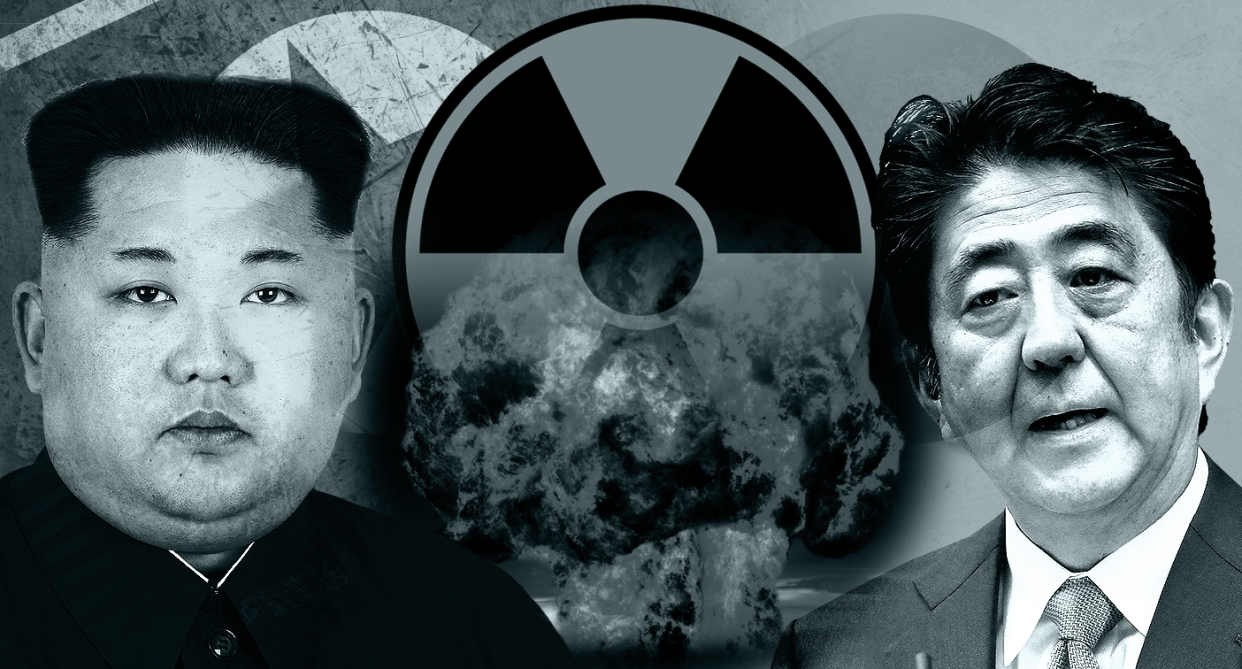
TOKYO — The streets of Kasumigaseki, Tokyo, were lined with side-by-side Japanese and American flags for President Trump’s arrival in early November. Inside the district’s government buildings, civil servants had carefully prepared to give the often-unpredictable U.S. leader a promising welcome on the first stop of his 12-day, five-nation tour through Asia.
Any fears that the U.S. would no longer defend Japan (stemming from Trump’s campaign rhetoric about “global freeloading”) virtually disappeared as the two world leaders golfed, dined, autographed baseball hats and reaffirmed their commitment to the alliance. Both men agreed it was the time for pressure, not dialogue, with North Korea and that the full range of U.S. military capabilities — both conventional and nuclear — would be available for Japan’s protection.
The threat of North Korea and escalating tensions in East Asia have recently driven Prime Minister Shinzo Abe to expand the powers of Japan’s Self-Defense Forces (SDF). But the country still relies mainly on the United States’ nuclear umbrella and military for protection.
But not all Japanese are pleased with this arrangement. As the only country to have been attacked with atom bombs, Japan has long been committed to abolishing nuclear weapons and upholding pacifism. The government abides by three nonnuclear principles: not to manufacture, not to possess and not to introduce nuclear weapons. Despite decades of disarmament treaties and pledges there are still an estimated 15,395 nuclear weapons on earth and the pace of their reduction has slowed in recent years.
From Nov. 5 until Nov. 11, I traveled through the island nation on a journalism fellowship from Foreign Press Center Japan. I met government and military officials, students, activists, intellectuals and civilians to see what different strata of Japanese society think about a range of issues, but we always circled back to a singular concern: How can Japan protect itself while upholding its pacifist ideals especially in light of increasing provocations from North Korea?

I visited the only cities to suffer atom bomb attacks, Hiroshima and Nagasaki, and the city that experienced the deadliest conventional bombing raid in history, Tokyo. What I heard revealed a country divided among realists, idealists and every shade in between.
“I’m nervous about North Korea very much and think they might attack Japan,” a young mother told me while browsing in Shinbashi Station market. “There is nothing Abe can do to stop this. Because they have nuclear weapons, I think we need to be prepared.”
Part I – Security
Article 9
After World War II, Japan adopted a constitution with a clause that outlaws war as a means of settling disputes: Article 9, which states, “the Japanese people forever renounce war as a sovereign right of the nation and the threat or use of force as means of settling international disputes.”
In 2014, the Japanese government approved a controversial reinterpretation of Article 9 that allows the SDF to fight overseas to defend allies, such as the United States, from attacks. The Japanese military hadn’t been able to fight abroad since World War II ended. This reinterpretation, the most drastic policy change in the SDF’S history, was made official by the National Diet, Japan’s legislature, in 2015 and it took effect in March 2016.
Yoshimitsu Morihiro, a deputy director at the Bureau of Defense Policy, said the law is limited to situations that ultimately threaten Japan’s security, and that the constitution still restricts the SDF from going overseas for combat missions and provides clear conditions for what constitutes peacekeeping.
“A key change introduced under new legislation is we can do partial, collective self-defense. It is really limited to a response to an attack against a foreign country that results in threatening Japan’s survival,” Morihiro said. “It would need to be a country that has a really close relationship with Japan and some kind of commitment to Japan’s defense. Simply, in the current situation, the best candidate is the United States.”
Abe still wants to change Article 9 so Japan can take a more active role in securing peace and stability but has not yet provided a complete draft for the revision — and the Japanese public is split. A poll from the Mainichi Shimbun, a major newspaper in Japan, was almost evenly split among those who support revising Article 9, those opposed and those who aren’t sure.
Internationalism vs. isolationism
Narushige Michishita, the director of the Security and International Studies Program at the National Graduate Institute for Policy Studies in Tokyo, said that Japan purports to be a pacifist country and that people believe it, but that Japan has supported most of the wars the U.S. has fought since World War II. In fact, Japan contributed $13 billion to the war effort during the Gulf War in 1991 — it just doesn’t send its own troops to fight.
“Pacifists don’t support wars or finance wars. We do all the time. When we say, ‘We are pacifists’ what we really mean is ‘We are isolationists,’” Michishita said. “Some people say we’re moving away from pacifism toward militarism, but that’s not true. We are moving from isolationism to internationalism.”

Michishita said most Japanese have been pleased to have the U.S. protect their nation rather than send their own men and women into harm’s way. But he sees the U.S. becoming gradually more isolationist. Former U.S. President Barack Obama said the U.S. will no longer be the world’s policeman and Trump’s inclination toward isolationism is well known. Meanwhile, instability in East Asia only appears to confirm Abe’s belief that Japan needs to contribute more to regional security.
Abe singled out North Korea as an imminent threat during a speech to the United Nations General Assembly on Sept. 21.
Missiles
At Japan’s Ministry of Defense headquarters in Tokyo’s Shinjuku ward I met with several other deputy directors at the Bureau of Defense Policy to learn about the defense systems they have in place to stop potential attacks.
Ryusuke Wakahoi, of the Strategic Intelligence Analysis Office for the Defense Intelligence Division, said the range of North Korea’s ballistic missiles is growing, and a new version, the Hwasong-14, which was launched twice in July, has a range of at least 5,500 kilometers. North Korean missiles can be hard to detect when they’re in place (that is, before launch), he said, because many are fired from a movable launch pad called a TEL (transporter-erector-launcher) or from submarines.
Since 2006, North Korea has conducted six nuclear tests. The most recent, in September 2017, released 160 kilotons of energy — the largest yet, ten times the power of the Hiroshima bomb. Wakahoi said it’s possible that North Korea has already been able to miniaturize nuclear weapons to mount them on missiles.

“We tried to have dialogue with North Korea but we failed to stop them from developing nuclear weapons,” Wakahoi said. “By offering time for dialogue we actually ended up giving time to them for developing nuclear weapons. And it’s highly unlikely we could change their mindset by having dialogue.”
Yosuke Nagata, of the Strategic Planning Division, said Japan’s ballistic missile defense (BMD) system uses installations on board destroyers to target long-range missiles and relies on land bases to protect against medium- or short-range missiles. He said Japan is working with the U.S. military to develop more advanced missiles and related technology to keep up with North Korea.
SM-3 missiles fired from Aegis destroyers are designed to stop ballistic missiles midcourse and Patriot Advanced Capability-3 (PAC-3) missiles are intended for the final stages of flight at lower altitudes.
“We developed BMD ships to defend Japanese territory and BMD architecture based on cooperation with the United States. We always need assistance from the United States,” Nagata said. “But it is very important to defend Japanese territory using Japanese capability.”
Nuclear Weapon Ban Treaty
Japan perplexed onlookers when it abstained from voting on the Treaty on the Prohibition of Nuclear Weapons (also called the Nuclear Weapon Ban Treaty), which bans the development, possession, transfer, use or threat of use of nuclear weapons, at the United Nations on July 7, 2017. In a historic vote, 122 nations adopted the resolution, and the 50 nations required for ratification signed the treaty on Sept. 20, 2017. This is the most significant international agreement on nuclear weapons since the Nuclear Non-Proliferation Treaty was adopted in 1968, although nations that already possess nuclear weapons, including the United States, do not consider themselves bound by it.
International and domestic supporters of the treaty criticized Japan’s decision to side with nuclear states but it wasn’t particularly surprising. Japan had voted against a 2016 resolution to negotiate the treaty ban in the first place and explained why it couldn’t support the treaty in a March 2017 statement: the treaty would not resolve security issues or lead to the elimination of a single warhead.
Part II — Peace
Surviving Hiroshima

The Abe administration’s push to revise Article 9 is a hard sell for many Japanese who grew up hearing stories about World War II. The government’s decision not to support the nuclear ban treaty was an even harder sell to the “hibakusha,” the survivors of the atomic bombs in Hiroshima and Nagasaki. After leaving the Ministry of Defense, I boarded the Shinkansen, or bullet train, for Hiroshima to hear from them firsthand.
Sunao Tsuboi, now 92, welcomed me into his office in Hiroshima on an overcast day after early morning rain. Some of the damage his body suffered on Aug. 6, 1945, was still evident on his ears and in his posture. Over cups of green tea, he told me about other hidden scars, clearly preserved in his memory.
The 20-year-old university student declined to join three older students for breakfast around 8:10 a.m. because he had already eaten. Five minutes later, the U.S. dropped an atomic bomb called “Little Boy” on Hiroshima. Tsuboi was 1 kilometer from the hypocenter: the point on the ground directly beneath the detonation. His classmates at breakfast died instantly.
“As soon as I heard the sound I ducked on the road. I was blown over about 10 meters from the blast. I have a slight memory of the moment because I had momentarily lost consciousness. When I came to, I couldn’t see anything 100 meters ahead because there was so much smoke and dust,” Tsuboi said.
He said under such circumstances you might expect someone to think about the fates of his or her loved ones, but he only thought about his hatred of Americans for dropping the bomb and vowing to one day get his revenge.
“I was educated to think in that way due to militarism. It’s so much different from these days. Every citizen thought that way,” Tsuboi said.
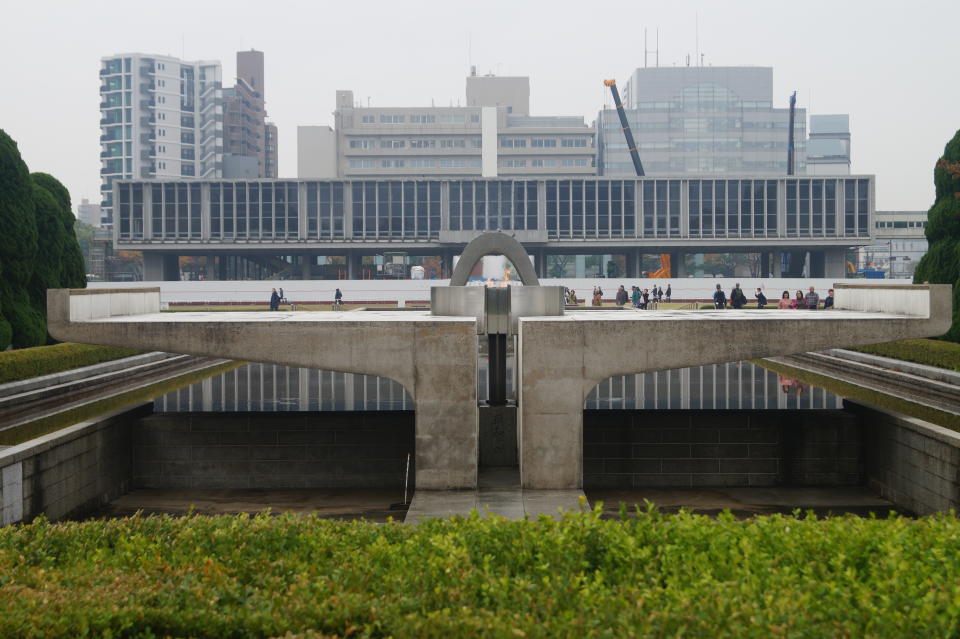
He estimates that “60 percent of people within one kilometer like me died,” and he expected to die himself. Walking to a relative’s house nearby, he saw people with severe burns over their faces, arms and feet. He looked in the mirror and saw his own injuries for the first time, severe burns across his body. Tsuboi ran off, holding his arms close to his body to ease the pain of his charred skin. He finally found a first-aid station that had been set up near a bridge and wrote a message in the dirt, “Tsuboi is dying here.”
A small military truck pulled up to rescue young men who could still contribute to the war effort. Women, children and the elderly were not allowed to take up spaces on the 10-person truck because they weren’t of use to the military. A little girl was trying to get on the truck but was scolded and sent away; she ran off, but in the wrong direction, toward the hypocenter. Tsuboi tried to warn her to run the other way, but she couldn’t hear him. He boarded the truck and was eventually taken to nearby Ninoshima Island to recover.
“I always think of her. She didn’t do anything wrong. She couldn’t find a place to escape and she must have died. Every survivor has a story like that,” he said.
Tsuboi, now the president of the Hiroshima Atomic Bomb Survivor’s Association, told me about his long road to recovery and chronic health problems throughout his life. Although many physical scars remain, Tsuboi no longer hates the United States. He has been to the U.S. nine times, and he prayed for the victims of Pearl Harbor while in Hawaii. Tsuboi even got to meet Barack Obama during the former president’s trip to Hiroshima in May 2016.
“I told him that we don’t hate the U.S. so we are not asking for your apology. The A-bomb survivors don’t want that. We have overcome such emotions and we should work together,” Tsuboi said.
Regarding modern warfare, Tsuboi said humanity should focus on things that all people can enjoy together regardless of race, like music, theater and art, rather than developing new weapons and “thinking of the best way to kill each other,” holding up his cane to mimic the action of shooting a gun.
“As long as I’m alive, I will never give up. We should all hold hands across the world regardless of race or color of skin. We cannot be happy when we’re trying to kill somebody else. We have to understand that fact,” he said.
Peace Memorial Park
The Atomic Bomb Dome in Hiroshima Peace Memorial Park is a remnant of the only structure near the hypocenter left standing after the bombing, an exhibition hall. Now its skeletal frame is a reminder of humankind’s ability to destroy and a symbol of peace. Kosei Mito, 71, has been volunteering as a tour guide around the site for 11 years.

Mito’s mother was four months pregnant with him at the time of the bombing and he suffered frequent illnesses throughout childhood. The “in-utero survivor” was holding the official pink certificate called the “A-bomb survivor’s health book” that was given to hundreds of thousands of survivors as he spoke to me about his strong belief that world opinion will lead to the abolition of nuclear weapons. He was frustrated that Trump said “anything would be an option” against North Korea and wishes Abe had told Trump that nuclear weapons should not ever be considered — even against North Korea.
He also accused the U.S. of hypocrisy, saying it has no right to tell other nations that they can’t possess any nuclear weapons since it already has so many. The United States has 6,800 nuclear warheads, surpassed only by Russia’s 7,000.
“I think in order to have a more convincing platform the U.S. should say, ‘We’re going to eliminate all of the nuclear weapons we have now so why don’t you get rid of the nuclear weapons you have with us?’” Mito said.
Masaaki Murakami, 24, who grew up in Hiroshima, works at a bar every night and volunteers alongside Mito every day. While discussing the tragedy, he showed me what he considers the most meaningful part of the park: the Atomic Bomb Memorial Mound, where the ashes of thousands of unidentified or unknown victims have been interred in a vault beneath a grassy mound.
Murakami thinks the U.S. and Japan are wrong about deterrence and need to understand that as long as nuclear weapons exist there’s a risk that someone may use them.
“During the nuclear era, deterrence may have been a viable option but it’s no longer the case. In my opinion, relying on the nuclear weapons of the other nations means we could be the target of a nuclear weapons attack,” he said. “I believe Japan should take advantage of its position as the only nation that’s experienced the atomic bombing. We shouldn’t follow the position of the U.S. and other nuclear nations.”
In Murakami’s opinion, young Japanese aren’t terribly interested in politics and don’t fully understand why Trump is problematic. He heard that Americans living in Japan expected large protests when Trump arrived but he believed, correctly, that wouldn’t happen.

“People are seeing a superficial image of Trump and his momentum and don’t think seriously about the details of the politics,” he said.
Murakami is also frustrated with Abe’s attempts to change the constitution. He thinks Abe is trying to capitalize on the positive image that the Japanese have of the SDF thanks to their disaster relief and rescue activities.
Just down the Motoyasu River, at the other end of the park, was the office of Kenji Shiga, director of the Hiroshima Peace Memorial Museum. Shiga said the museum’s exhibitions were intended to be thought-provoking, not didactic, evoking a range of responses. When asked if nuclear abolition was too idealistic, Shiga affirmed his belief that humankind can one day eliminate nuclear weapons from this world.
“The reason I think we can eliminate nuclear weapons from the world is I believe in the intelligence of human beings. We have a similar experience in the past. Humans have eliminated and gotten rid of weapons like poisonous gas and land mines,” Shiga said, with perhaps a touch more optimism than recent history warrants. “So humans have been making a certain effort for a long period of time. Now the United Nations is also making an effort with the Nuclear Weapons Ban Treaty. I’m sure such efforts will continuously be made.”
Memories of Nagasaki
The next day, I boarded the bullet train again, for a trip to Nagasaki, where the second and final atomic bomb used in war exploded on Aug. 9, 1945.
Takashi Kado, 82, met me at the Nagasaki Atomic Bomb Museum wearing a light-green windbreaker with “Nagasaki Peace Guide” emblazoned across the back. He is healthy, active and, in his words, “very lucky.”

He lived about 3.5 kilometers from the hypocenter and was 10 years old when the U.S. dropped the bomb nicknamed Fat Man. He had been playing on the road near his house in the hot summer sun when he noticed a strong flash that made him look up to the sky. Two seconds later, he heard a calamitous sound and thought that a star had fallen from the sky. His teacher had just taught him about stars before summer vacation. He also remembered his teacher told him if a bombing occurred that he should take cover under his desk, but he was outside, so he knelt on the streets and covered his eyes. About seven seconds later, the blast swept through the street and threw him against the wall of his home.
“I was scared and frightened. I didn’t know what to do. I was shaking, terrified. My mother called my name, ‘Takashi, Takashi!’ and I told her I was not able to move,” Kado recalled. “My mother ran to me. She grabbed my arm and pulled me into the house.”
Kado heard a voice bellow over the neighborhood loudspeaker, “The enemy is attacking! The enemy is attacking!” Grabbing a backpack with emergency supplies, such as a poison-gas mask, that he always kept near the front door, he and his mother took off toward the community shelter, an eight-minute walk from his home. They passed many bloodied, elderly people in the street whom they were unable to help.
“My mother wiped their faces with her apron and told them she was sorry but that she needed to escape as well. That is a very tragic history for one young boy,” he said.
As we walked through the museum, Kado shared a string of memories from life during wartime: the sound of American planes during the frequent air raids, the hunger from the food shortage and the image of his mother praying that the bombs would not strike their house.
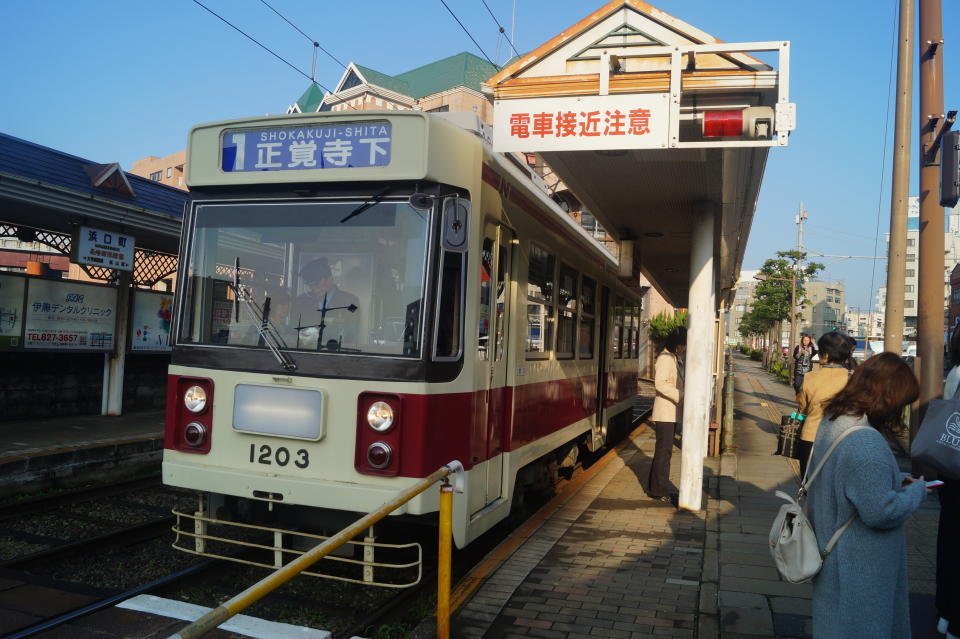
Before parting ways, I asked Kado what he thinks about the current North Korea situation. He said that Japan should become friends with North Korea and work together to foster cross-cultural understanding. He said more people need broader minds — something severely lacking in North Korean leader Kim Jong Un.
“He is stupid. Kim Jong Un is a crazy man. So that is the honest opinion about North Korea. It is inhumane,” he said.
Research Center for Nuclear Weapons Abolition
The Research Center for Nuclear Weapons Abolition (RECNA) at Nagasaki University — only a five-minute cab ride from the Nagasaki Atomic Bomb Museum — was founded in 2012, inspired by Obama’s 2009 speech in Prague about “America’s commitment to seek the peace and security of a world without nuclear weapons.”
RECNA has three main objectives: to research, analyze and circulate information on the significance of the atomic bombing experiences; propose actions that could lead to the abolition of nuclear weapons; and cultivate a new generation of storytellers to share the experiences of the hibakusha when they’re gone.
Tatsujiro Suzuki, the director of RECNA, said Japan faces what he’s dubbed a “nuclear trilemma.” Along with its desire for deterrence and abolition, Japan needs to address its 47.8-ton stockpile of plutonium, which is the largest of any nonnuclear state and amounts to “latent nuclear capability.” Japan has been developing civilian nuclear energy since 1956 by recycling spent nuclear fuel to recover plutonium. The nation wanted an “indigenous nuclear fuel cycle” because it barely has any natural resources.

“Naturally people are suspicious of Japan’s accumulation of plutonium. Only 8 kilograms are necessary to make a bomb. Now Japan has 47 tons. So that’s a lot,” Suzuki said. “Even though Japan has committed to not making any nuclear weapons and this plutonium only has civilian uses, this huge supply makes Japan vulnerable to international concern.”
Suzuki thinks Japan should have supported the U.N. treaty prohibiting the possession and threat of nuclear weapons. He said it’s a good time for Japan to shift to a security policy that does not rely on nuclear deterrence.
RECNA is devoted to a specific policy goal of establishing a nuclear-free zone among three countries in Northeast Asia: South Korea, North Korea and Japan. Then China, Russia and the United States would provide negative security assurance, which means they would agree not to attack or threaten to use nuclear weapons against those three countries. North Korea has not accepted invitations to join these negotiations.
“There is no evidence that deterrence works. This is about the current situation. If nuclear deterrence perfectly worked, why would we have to worry about North Korea? We have them already. Dependence on deterrence does not have assurance. I would ask them, OK, you believe in nuclear deterrence. Why are you worrying now?”
Suzuki argued that Abe is pushing Japan toward militarism and that the security laws passed last year are unconstitutional. He said enabling the SDF to collaborate with the U.S. all over the world violates Article 9 and that the clause limiting their deployment to situations threatening Japan’s survival is too vague.

Nagasaki University students
Hanako Misuoka and Jo Takeda, both 21, have been involved with RECNA while studying at Nagasaki University. They stopped by the center to share their thoughts as young Japanese concerned with nuclear proliferation.
Misuoka, from Saga Prefecture, studies education but doesn’t want to become a teacher. She wants to establish an education reform organization because she thinks Japanese education curricula are too biased and that students rarely get the whole story. Takeda, from Kumamoto, is preparing for a recruitment exam for the Ministry of Foreign Affairs. He wants to work on nuclear weapon issues and cultivate understanding between different cultures through diplomacy.
They said the Japanese public is almost evenly split between people favoring nuclear abolition and people who want to maintain deterrence, mostly against North Korea. But for their part, they favor signing the controversial U.N. treaty.
“If Japan becomes a signatory of the treaty it will boast some influence on other countries,” Misuoka proposed.
She said she had an opportunity to teach at an elementary school a few days earlier and was surprised that none of her students had heard of the International Campaign to Abolish Nuclear Weapons (ICAN), which was awarded the Nobel Peace Prize this year.
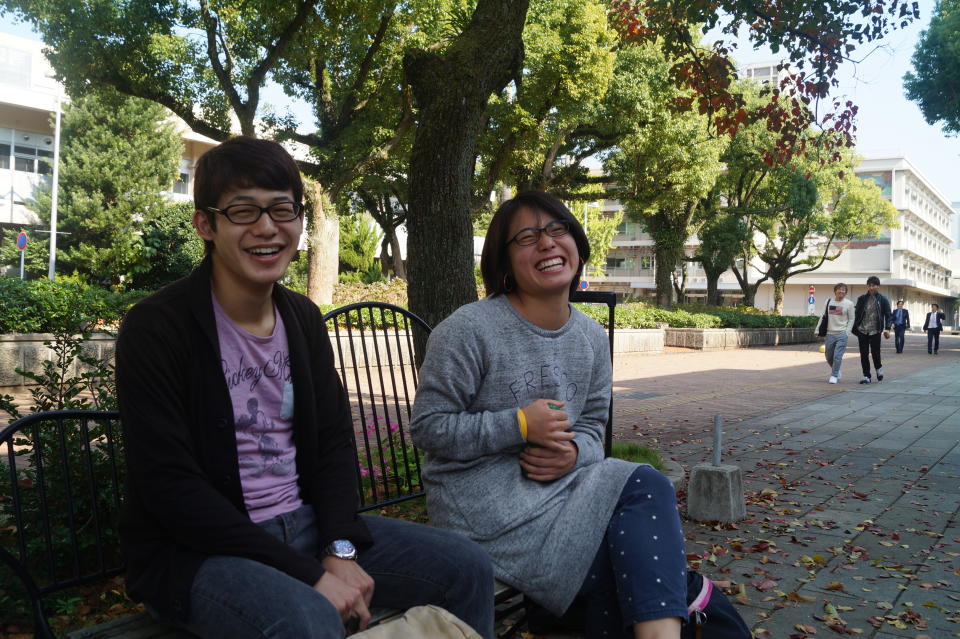
Both students said they harbor no ill will toward Americans for the atomic bombings and that it’s more important to work toward peace and nuclear abolition today than dig up old grudges.
“It’s history. We did something bad to each other. We did Pearl Harbor. You did the atomic bombing. But the war is over,” Takeda said. “Of course, history is important but the current issue is more important. We need to cooperate with each other to prevent another war. We have to remember but I don’t blame American people today.”
Both students appreciated Obama’s trip to Hiroshima and said it had long been a wish among survivors for a sitting U.S. president to visit. They said visiting Hiroshima or Nagasaki goes a long way in raising a person’s awareness of nuclear issues.
“From my story, I wouldn’t be interested in nuclear weapon issues if I didn’t come to Nagasaki. I think it’s important for people from nuclear weapons states and under a nuclear umbrella to come to Hiroshima and Nagasaki,” Takeda said.
Misuoka wishes that Abe would stand up to Trump and encourage him to pursue more diplomatic methods of resolving conflicts.
“When we look at Obama and Trump it seems that Obama is committed to peace and that Trump is trying to increase the military capability and insists on ‘America First.’ [Our] Prime Minister doesn’t say ‘no’ to anything that Trump is saying.”
Part III — Pride
Nagasaki defense today
I took the Nagasaki tramcar to meet Hiroharu Aoki, the director of the Crisis Management Division for the Nagasaki prefectural government. He greeted me at his office wearing a lapel pin, with the Japan and U.S. flags side by side, that had been given to him by a captain in the U.S. Navy’s Seventh Fleet, which is headquartered in Yokosuka, roughly 40 miles south of Tokyo. Aoki was an officer with the SDF until two years ago.
Aoki’s division is preparing with the national government for a missile attack drill scheduled for Nov. 22 — the first of its kind. The national government already sends “J-Alert” warnings of terror attacks or natural disasters to local media and citizens via smartphones, email and loudspeakers.

“It’s a very outstanding mission to be able to protect the peace and independence of the nation, and the lives of the people,” Aoki said. “I have worked in the SDF for 37 years after graduating from the National Defense Academy of Japan. And my son is also an officer. I’m very proud of that.”
For Aoki, the new Abe laws are simply the legal basis for Japan to contribute to peace and security on a level comparable to its allies. He said that although the national government and SDF have set up ballistic missile defense for potential attacks, individual preparedness among residents, such as access to shelters, is inadequate.
“On the resident level, it is not easy to set up a shelter. So we can have a drill and call for an evacuation and encourage citizens to be ready for an emergency,” he said.
Aoki keeps a map of East Asia on his wall with concentric circles rippling out from Pyongyang. Each circle represents North Korea’s potential reach with various weapons. Given its location in Southwestern Japan on the island of Kyushu, Nagasaki is close to the Korean Peninsula.
Talking to Aoki reveals his sense of duty and deep-seated desire to defend his nation, prefecture and city. After leaving his office, I took a cab to Nagasaki Airport to catch a Japan Airlines flight back to Tokyo — with a newfound appreciation for the pride that men and women of the SDF feel for contributing to Japan’s security alongside the United States.
Former minister of defense
Gen Nakatani, who served as the minister of defense under Abe from December 2014 to August 2016, is now a member in the House of Representatives, the lower house of the National Diet. His office, across the street from the National Diet Building in Chiyoda, Tokyo, is decorated with graceful Japanese calligraphy, as well as photographs from his extensive career in politics and the military.
Nakatani used to train the Self-Defense Force rangers and said he still knows what’s going on in the field. Every January, he said, he participates in parachute training with current officers, which helps build a sense of unity in their mission to “defend the country together.”
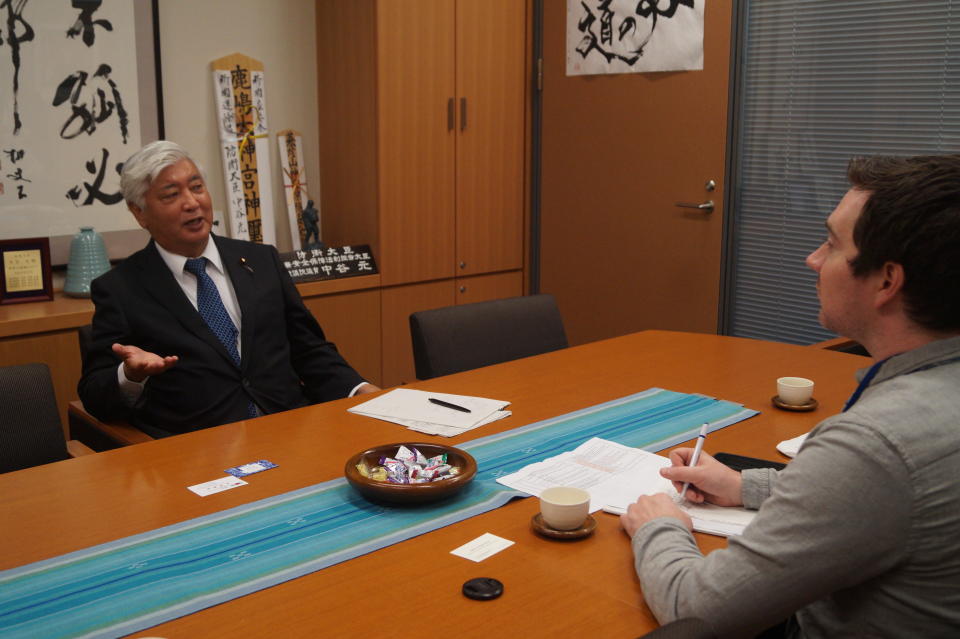
According to Nakatani, it’s time to place sanctions and other forms of pressure on North Korea because it has already broken its promises to stop pursuing nuclear weapons after the six-party talks. Japan and the United States are in agreement on that policy.
“They’ve conducted six nuclear weapons tests. The latest nuclear test’s size was about 160 kilotons, 10 times larger than the Hiroshima atomic bomb,” Nakatani said. “Of course, we will not allow such provocative threats to the international community. It’s on an unprecedented scale and threatens the entire region. This is a great and immediate concern for us.”
In order to protect the Japanese people, he said, the SDF will keep working with the U.S. to make sure it can intercept North Korean attacks with SM-3 and PAC-3 and will in other respects have the right defense system in place.
“Of course, this was one of the topics discussed by Trump and Abe,” he said.
He added that the Japan-U.S. alliance is the most important international agreement to secure peace and stability throughout Asia.
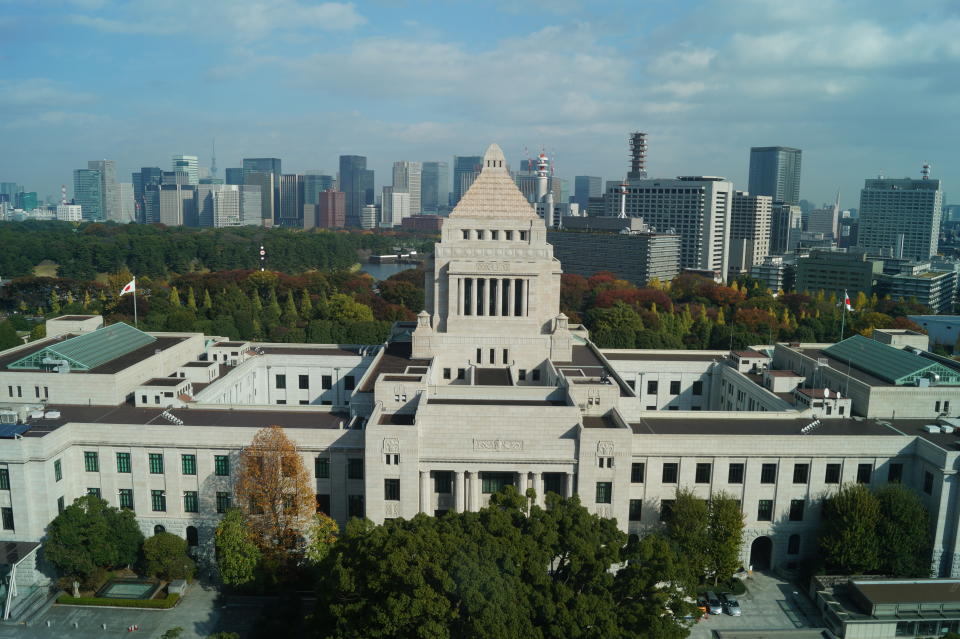
Nakatani said Japan will continue to advocate strongly for nonproliferation of nuclear weapons but that threats from North Korea, China and Russia make it necessary for Japan to rely on the United States’ nuclear umbrella. He said the Treaty on the Non-Proliferation of Nuclear Weapons was established with the understanding that the U.S., Russia, the U.K., France and China are nuclear weapon states and that dramatically disrupting the current world order could be dangerous.
He was also grateful that Trump met with families of Japanese citizens who have been abducted by North Korea.
Abduction of Japanese citizens by North Korea
The abduction issue is a major roadblock for Japan-North Korea relations. During the ’70s and ’80s, many Japanese citizens disappeared under strange circumstances. Japanese authorities concluded through subsequent investigations that North Korea was involved and brought the issue up at every chance since 1991. Finally, in 2002, North Korea admitted that it had abducted these citizens, returned five and promised to stop. But there are still many points of contention between the nations.
The motivations behind the abductions are not clear in all cases. But the Japanese government says North Korea had at least three reasons for these crimes: North Korean agents could steal the identities of the abducted Japanese citizens, victims could be forced to teach North Korean spies Japanese language and culture and victims could be recruited for the “Yodo-go” terror group, which infamously hijacked Japan Airlines Flight 351 in 1970.
The Japanese government official recognizes 17 people as abducted since 1977 but some suspect there were hundreds of victims. The North Korean government, on the other hand, claims there were only 13 victims and that eight have died and five have been returned — thus resolving the issue.
Japan says that North Korea has not produced any credible objective evidence corroborating the claim that the remaining missing persons have died. Cases like the abduction of 13-year-old Megumi Tokota from Niigata Prefecture in 1977 are well known in Japan. Her pictures were prominently displayed on the walls of the Shinjuku subway station in Tokyo while I was there.
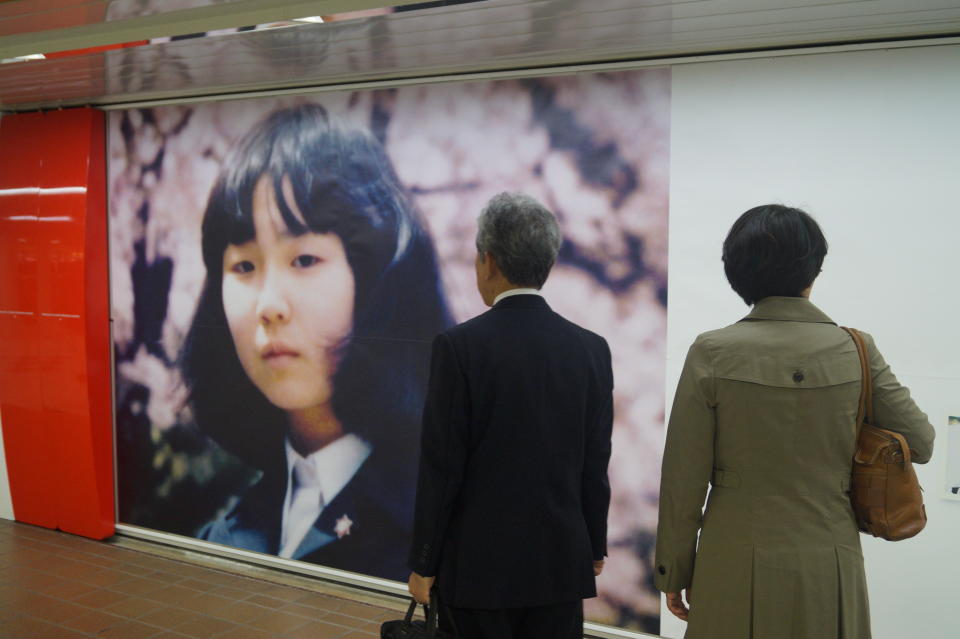
The Japanese government maintains that it will not normalize diplomatic relations with North Korea until the abduction issue is resolved.
I met with Masahide Adachi, the director for the Office for the Assistance of the Abductees and their Family Members, to discuss recent developments on this issue. During our conversation, Adachi and members of his staff were wearing blue ribbon-shaped pins, a symbol of hope that one day the abductees will return home.
He pointed out that Abe has been referring to these abductions at various international meetings and conferences since taking office. He said the Japanese government urged Trump to meet with the families of abductees and that it didn’t take long for him to agree.
“I think awareness of this issue in the United States has been on the rise partly because of the nuclear missile issue of North Korea, and human rights issues are of course important for the U.S.” he said.
In September, Trump became the first sitting U.S. president to refer to the abduction issue during a speech to the U.N. General Assembly. Although Obama and Bush had met with some family members, Trump’s invitations went to every family member for each victim and 17 people in total were able to attend.

“When the families met with Trump and were able to get close to him they were only supposed to talk for 20 minutes but it wound up being 35 minutes,” Adachi said. “Trump stayed focused and listened to what each family member said. He shared their feelings and was very compassionate.” He said meeting the U.S. president is not the end goal and that it won’t mean much if it doesn’t help resolve the issue, but it was successful.
“That the president of the United States, the most influential nation in the entire world, met with the abductees’ family members and was very compassionate meant a lot,” he said.
Adachi said he also hopes the international pressure building around North Korea’s development of nuclear technologies will make Kim resolve the abduction issue. When asked if he would support any use of force to rescue the remaining abductees, Adachi said the government’s policy is to continue pursuing dialogue and applying pressure.
“The government will continue to do its best,” Adachi said. “Where we are right now resembles what went on in 2002 when five abductees came back to Japan.”
Center for the Promotion of Disarmament and Non-Proliferation
Hirofumi Tosaki is a senior research fellow at the Center for the Promotion of Disarmament and Non-Proliferation, which is dedicated to achieving the goal of “everlasting world peace.” But he supports the Japanese government’s position of not signing the United Nations nuclear-ban treaty.

During our conversation at the center’s Tokyo headquarters, which is part of the Japan Institute of International Affairs, a foreign-policy think tank, Tosaki argued that adopting the treaty without the cooperation of nuclear-armed states would merely exacerbate the divisions between nuclear states and nonnuclear states, as well as between nonnuclear states under and outside of nuclear umbrellas. He also said the treaty is unlikely to lead to disarmament concessions.
Although he would like concrete steps to promote disarmament, Tosaki thinks Japan’s erratic relationships with North Korea, China and Russia make the U.S. nuclear umbrella vital, until threats have been reduced significantly. He is sympathetic to the hibakusha and NGOs calling on the government to support the treaty, but he said their arguments aren’t accepted by the ruling party, some opposition parties, or the general public.
“We understand that nuclear weapons are very dangerous, inhumane weapons but because of their destructive power they work as a deterrent,” Tosaki said.
Tosaki explained that proponents of the ban treaty do not expect it to make a significant dent in nuclear stockpiles yet. They are, he continued, trying to reframe the narrative around humanitarian concerns by stigmatizing possession.
Japan, on the other hand, favors a “progressive approach” through which nuclear-armed states take simultaneous and parallel steps to break through the current disarmament gridlock.
In conjunction with Hiroshima Prefecture, the center has been publishing an annual “Hiroshima Report” evaluating the current state of nuclear disarmament since 2011. In the most recent edition, they concluded that prospects for eliminating nuclear weapons from the world “are still distant at best.”
Leaving Japan
One of my last interviews before leaving Japan was with Go Ito, a professor of international relations at Meiji University. He argued that North Korea’s pursuit of nuclear capabilities stems from its feeling of having been abandoned by former allies Russia and China after they resumed diplomatic relations with South Korea in the late ’80s and early ’90s. It’s a dream the country has harbored ever since: “My understanding is that North Korea was an abandoned country so they think nuclear weapons are the only method for them to survive.”

U.S. and Japanese officials have declared that it would be absolutely unacceptable for North Korea to maintain nuclear weapons for decades. But what does unacceptable really mean? Would either country be willing to preemptively attack North Korea to make them stop? That doesn’t seem likely. Right now, we are looking at a world in which North Korea has become a nuclear state — like it or not.
North Korea insisted for years that it wanted a nuclear weapon for deterrence just like the U.S. and Japan have. As I entered Narita International Airport for my flight back to New York, I thought of something David Denoon, a former deputy assistant secretary for the U.S. Department of Defense who now teaches politics and economics at NYU, told me before the trip:
“North Korea now has effective deterrence. And that means that nobody is going to attack them without the very high probability of starting war. Both Republican and Democratic administrations have made a mistake saying that a North Korean nuclear weapon is unacceptable because it’s not clear what we would do once the North Koreans demonstrated that they have a nuclear weapon.”
On Nov. 20, nine days after I returned, Trump announced that his administration was restoring North Korea to the United States’ list of state sponsors of terrorism, adding to Pyongyang’s diplomatic isolation: “It should’ve happened a long time ago. It should’ve happened years ago.”
There was some hope at the time of my visit that the U.N. resolution in September strengthening oil sanctions against North Korea might be working, since North Korea had not launched any ballistic missiles in about two months. But on Nov. 28, North Korea fired a ballistic missile into Japan’s exclusive economic zone.
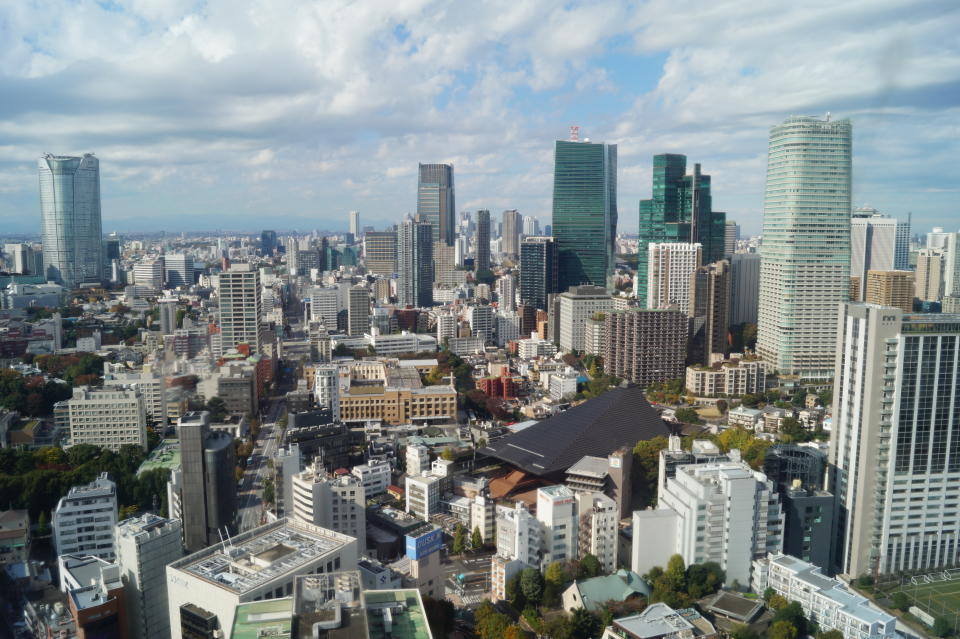
During my visit, I met many Japanese who are worried about the threat of North Korea but have different views on how the government should respond. Despite their reservations about Trump, essentially everyone with whom I spoke valued the U.S.-Japan alliance as central to the nation’s security and understood — even if some fundamentally disagreed with — why Japan would rely on the U.S. nuclear umbrella. Support for Abe’s moves toward greater self-defense capabilities has understandably risen along with Kim’s nuclear capabilities, but revising Article 9 is still a much-debated and controversial issue. And a sincere desire for pacifism and nuclear disarmament was strongest in people and places closest to the atomic bombs — arising from indelible memories that animate much thinking about war and peace in Japan.
Pacifism has been a central pillar of Japan’s national identity since the end of World War II. There are hints that the commitment of the Japanese people to this ideal has been changing. But the collective memory of the atomic bombs and decades of peace have all but guaranteed that these changes will be gradual and thoughtful.
Read more from Yahoo News:

 Yahoo News
Yahoo News 



